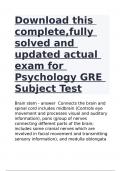Exam (elaborations)
Download this complete,fully solved and updated actual exam for Psychology GRE Subject Test|GUARANTEED SUCCESS
- Module
- GRE PSYCHOLOGY
- Institution
- Oxford University (OX)
Brain stem Connects the brain and spinal cord includes midbrain (Controls eye movement and processes visual and auditory information), pons (group of nerves connecting different parts of the brain; includes some cranial nerves which are involved in facial movement and transmitting sensory informat...
[Show more]



